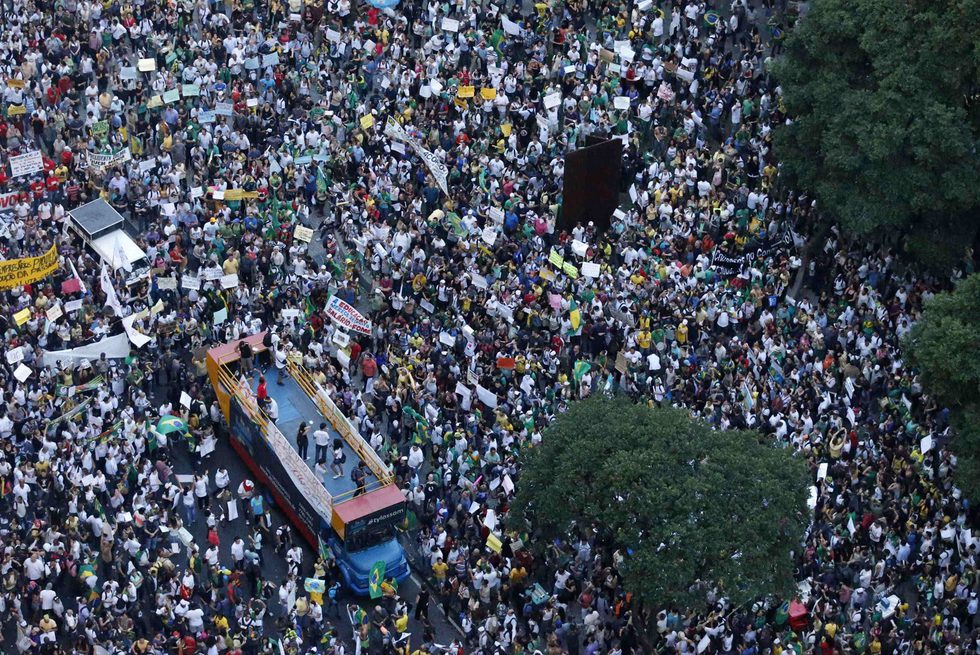Protests in Brazil
From the Series: Protesting Democracy in Brazil
From the Series: Protesting Democracy in Brazil

It is important to stress from the start that no one predicted the protests that occurred in Brazil in June 2013 and that are still with us in modified forms. Although this was felt as a bit embarrassing for the so-called “political analysts” it also probably says something about the nature of our endeavor and calls for a bit of modesty on our part. Anyhow, in spite (or perhaps because of) its great heterogeneity it can be argued that, overall, these protests signaled in very diverse ways a potent critique of a model of development that has, in its more general features, survived many governmental periods. In fact, it may have also signaled that, beneath all the differences involved, there is a common substratum that includes the 1964–1985 military regime but also our democratic periods before and after this interregnum. Disclosing what could be these common features is a task for the years ahead, but a fair guess is that they include: structural authoritarianism, lack of citizenship, exaggerated emphasis on big business and big projects, neglect of common needs and social diversity, and also an incipient big power syndrome. One of the banners waved during the protests seems to say more than many of our analyses: “A rich country is not where poor people have cars; it is where rich people use public transport.”
Public transport and its malaise did indeed figure prominently during the bigger protests in the bigger cities, but certainly that was just a way of starting a wider conversation, so to speak. And in fact there were many more microscopical protests going on in many different parts of the country before those that the media chose to focus on. Mapping, assessing, and situating chronologically all of these protests will also be a task ahead of us.
There was a lot of anxiety in trying to discover who the main actors in these protests were. For a time they seemed to be, and be connected with, the traditional urban middle-classes to which the media gave special attention. But not only was this assessment due in part to a certain bias, but the participants also changed over time and place. The forms of protest also changed. There was a certain shock at the more violent varieties of protest, but it could be argued that they had an important role in changing the initial view that the more traditional middle-classes were in control. More will have to be known about these more violent protests and also the reasons why they provoked such perplexity and fear in spite of the fact they were so few in number.
Anthropologists should point out that the protestors did not limit themselves to the more visible protests and to their “social networks” in the metropolises. The reverse could be argued, in fact: that the more urban protests represented a climax of a movement that started in the so-called peripheries and that the Indians had a particularly important role due to their very significant protests in different parts of the country against violent inroads on their land, assassinations, big dams that will bring considerable damage to the environment, etc. In a way for the first time, the country as a whole identified with its living Indian population. It was impressive to see their presence even in cities such as Rio de Janeiro, where the resistance against the decision to put down the, former Indian Museum (where a group of Indians and sympathizers had camped) in order to establish parking lots for the 2016 World Cup was a success.

Side by side with political consequences, these protests will also have theoretical and epistemological implications that will be difficult to disentangle. For instance, the dualism between State and Market that has to a large extent dominated public debates should now be challenged due to its failure to take into account actual social groups with their concrete interests and aspirations (and it is to be hoped that anthropologists may have a say in this). On the other hand, coming back to the feeling of surprise that the protests provoked, it is possible that the notion of a strong opposition between a civil state and a state of nature that goes back to Hume and Locke may be at least partially responsible for generating it. I would suggest, in this regard, that we all should read more Spinoza whose criticism of the above theoretical and epistemological posture and of the idealism of philosophers seems very timely and in tune with the most interesting current trends in anthropology. We should also pay more attention to the “peripheries” and start seeing what happens there not as exceptions, but as vantage points from which to view the world in a less biased way, more clearly identifying undercurrents and recessive trends that insist in surprising us.